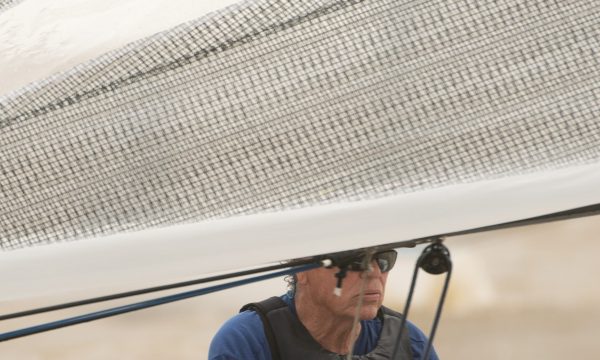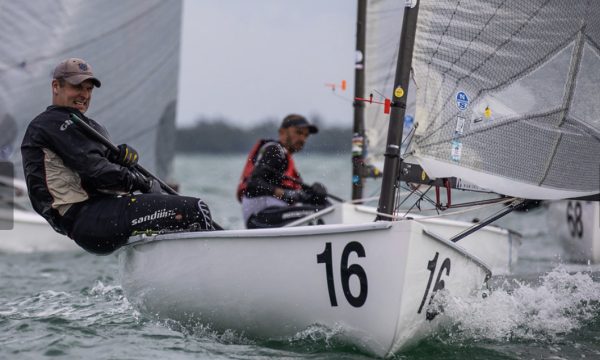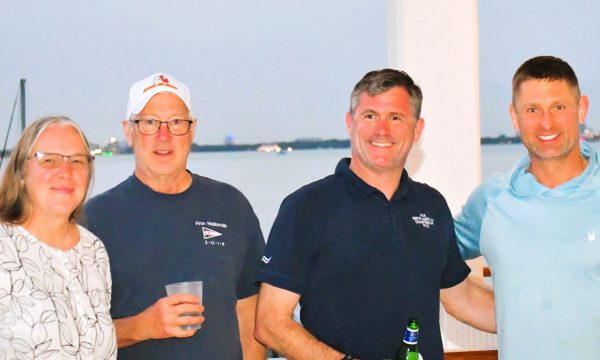Since I started racing sailboats at the age of 14 [1970], I’ve always wanted to sail a Finn. At Goguac Yacht Club [Battle Creek, Mi] the best sailor in the club, owned a black Thistle and a black Finn. Dave McDill was built like a linebacker and his wooden Finn was gorgeous and had a huge compass. He was always sanding on a bondo area on the hull, I suspect now it was a low area that he built up to fair the hull.
That Finn always impressed me and became my personal gold standard for single handed boats.
Fast forward 20 years after graduating with honors from the United States Naval Academy [Annapolis] and serving in fast attack submarines. I was racing IOR boats as tactician/helmsman, owning a Thistle and moving for careers more times than I can count I ended up at Lake Geneva Yacht Club with Brian Porter, Jane and Bob Pegel and Buddy Melges during his America’s Cup 1992 run, eventually winning an America’s Cup with Bill Koch. The talent was deep.
I couldn’t quite get my head wrapped around Inland Lake Scows initially and was talking to the Harkens and Chuck Miller at North Sails in Pewaukee, about sailing a Finn. Chuck [who had competed for an Olympic spot in Finns] was very kind and gently steered me away from the Finn at the time, I think mostly because he wanted me sailing locally and at the time I was about 175 lbs. We eventually got an M 20 scow, and Karen and I found some success as a team. I went on to own and sail every type of Scow, getting a tip or two from Buddy Melges on occasion and began to appreciate the type and found some success in racing, finishing in the top third of the E Scow Nationals out of 120 some boats. I didn’t remember, but John Porter was also racing Finns and looking at an Olympic campaign.
We moved again for work and my next boat was a Megabyte, as close as I could come to a Finn. It didn’t get much of a workout due to move to Hong Kong SAR, China and was sold along with a single rowing shell and a couple of cars a few years later. Our 5 year contract as ex-pats turned into a single year and we ended up in Austin, Texas. Life got in the way and we couldn’t think about racing for over 10 years.
Finally, in 2015, we got some stability in our lives and water in Lake Travis. Karen and I missed racing and decided to start sailing again. The Austin Yacht Club depends heavily on volunteers to run the club, and encourages people to buy the boats that people are racing in their local fleets. There are tens of dinghy types , but no real strength to any class as the summers are windless, blistering hot and most people don’t like getting wet when the temperature drops in the winter. There were no Finns at the club, and no active Finns in Texas. The surviving single handed classes are Sunfish and Lasers that race for a couple of hours informally in the evening once a week.
My desire to own and race a Finn had never disappeared completely. I began to research what the class was doing and found an active scene in Europe, but a less active class in the USA after dominating the world’s hull and equipment design for years. It was then that I started talking to Tim and Kay Tavinor at Petticrows about their new Finn molds [2015]. Despite the numerous warnings I received about the Finn being really athletic, difficult to sail and not supported locally, I liked what I saw and the British Pound was at a multi decades low against the Dollar, bringing a new boat within range of good used equipment.
I didn’t have a sponsor at the AYC, but I had a plan, and presented myself to the membership board. The board was skeptical that I would really buy an Ensign to fleet sail and that I would buy a Finn to race by myself even after presenting pictures of past boats and a sailing resume. I pushed ahead. Shortly after being accepted as a member, I purchased Petticrows Finn hull #30 [ISAF 4470 ], and found a late model Ensign, #2021 , for Karen and I to race.
I couldn’t be happier with the purchases. The two boats have complimentary characteristics and respond to tuning. Both the Ensign and Finn class have been very welcoming and supportive. I have new Finn friends in the USA and Europe and have gotten acquainted with my boat with great pleasure.
Pettcrows have done an excellent job with the Finn. I told them that I didn’t have an extensive shop and that I wanted the boat ready to race. Tim Tavinor made perfect recommendations on all of their options and the boat is lively and exceeds my expectations. The quality of the workmanship is excellent, and the Petticrows Finn feels great. Without any Finn racing experience, I put in a respectable performance at the most recent North American Masters.
The most difficult decision I had to make was the deck color and design. I eventually threw up my hands and went with a single topside color, RAL 1013 Oyster White, which is a yellow gray off-white color. It’s a very traditional deck color, and it’s perfect for the bright Texas weather. It’s cool to sit on and easy on the eyes. This choice has received more notice than anything else, and Petticrows thought it was a brilliant choice as they built the boat.
==============================================================
Buying the boat.
I researched the heck out of buying a Finn. There weren’t many used boats advertised [all the old hulls need some pretty extensive mods requiring an experienced hand], and the newer used Devoti, Wilke, Pata, etc. boats hold their value due to the difficulty of importing boats, making them a little pricey. Additionally, the carbon fiber spars are custom built to the owners, so there’s always a fudge to account for.
I am a total fan of Petticrows. I can’t say enough good things about Tim and Kay Tavinor. Their Dragons are first rate and beautiful, but their new Finn is a class act of science and engineering. Go here to see the story that convinced me – http://petticrows.co.uk/finn-tech-and-build.shtml
When I was looking, there was no distribution for Petticrows in the USA. I contacted Tim and Kay by email and asked their opinion on the suitability of the Finn for a 60 y/o athlete and details about who sailed the boat, etc. Along with the recent articles in FinnFare about the morphology of a Finn sailor, and some discussions with Rob Coutts [on Facebook], I decided that a new boat was possible. I was able to order directly from the Petticrows boat works.
Ordering was just a matter of completing a form and wiring the deposit. The credit union was able to send the money in British Sterling and made the conversion. The actual transaction only took about three days to clear. We were off faster than a prom dress! The hull was placed into the production queue ; the mast , rudder, boom, and sail [matched to the mast] were ordered.
The long straw for delivery was not the hull, but the Wilke mast and the North Sail took forever to be received and consolidated into the order. When everything was ready, the boat, trolley, mast and other gear was packed into a 20 ft container and picked up for the sailing port. I was able to track the slow boat to Houston, which t seemed to take forever, and then picked it up from the dock using a freight forwarder. The transportation from the dock of Houston to the Freight forwarder offices, on a dollar-per-mile basis , was the most expensive part of the whole process. The Freight Forwarder was great, did a super job of unpacking the boat and helped me load the boat and trolley on a car carrier [the least expensive option if you don’t have a dedicated combination trailer]. The Freight Forwarder was also my agent and took care of all the paperwork, taxes and duties as part of their commitment.
I didn’t have everything worked out, so the mast was a little insecure initially and the roads around Houston were a mess, but I managed to get everything home in one piece and delivered to the yacht club, just after dark. The next day I put the boat together, measuring out the control lines for the first time and bending the sail on the spars.
It was January, and even in Austin it took a few days to get the right weather for the wetting down. The day finally came and the first sail was not in great wind, but good enough to check out the boat and how it was going to feel in more air and get a few tacks and gybes in to gauge the boom height and rigging. Check SAT.
Sailing the boat.
Until I got the feel of the boat, I scheduled my sailing for days with people around, just in case I ran into trouble. I programmed my initial outings for increasing winds and did lots of tacks and gybes. When I did finally start racing, I had a good feel for the roll rate and rudder response. I was surprised at the amount of control I had over sail shape and power. Following the tuning guides I got the first sailing in wind over 12 mph up to about 18 mph in the gusts and everything was in control and the rig depowered well.
My first capsize was a slow motion roll to leeward caused by my life jacket getting hung up on the boom. I was pinned and the boom was pinned with me. I flopped into the water with the mast floating and got to the centerboard in time to muscle the boat upright. The Petticrows Finn comes up dry, I didn’t believe Tim and Kay at first, but my experience is that the boat was drier after the capsize. The boat has transom ports, a big bailer and a smaller “automatic” bailer with remote control lines.
At this point, the boat is upright, sail luffing out to leeward, rudder down and completely stable hove to across the wind, floating high and dry. I reached up and grabbed the traveller bar and pad lacing and gave a heave. I almost got back in the boat, but I got hung up just before my center of gravity got over the rail. A couple of more tries and I was exhausted. I drifted down the course to the start finish line still stable, sail luffing. A couple more tries and it was evident that I wasn’t getting back in the boat without help. Lucky for me, some wispy teenager took pity on my fat sorry self, capsizing his Laser, swimming over to lee side of my boat, launching himself over the gunwale, extending a hand to me and pulling me into the boat. He left as soon as I was in, . . ., oh to be young again. I have since put step assist lines on both sides as recommended on the FinnUSA.org website.
I haven’t found any really bad habits with the Finn, yet. I still have to race in over 20 mph and get my downwind angles figured out. At 61 and 205lbs, I still swim 16-20 thousand yards a week in a masters swim team workout. Energy management and strength training is important and I’ve been trying to sail myself into regatta shape.
The Finn is probably one of the best sailing boats I’ve owned, it just feels right. It sets up like a DN iceboat, that also sheets in hard going upwind using the mast bend to depower in the puffs. You get paid to hike, but it’s not a gut busting set up. Racing with Lasers, I owe them a 1% handicap or about 18 seconds over 30 minutes, or about 60 yards. Racing against Sunfish is about a 10% delta, or 3 minutes over 30 minutes of racing, about 300 yards, a good drive in golf. I start late and I can usually make my time, especially using the compass and getting in phase with the shifts. Many times I’m by myself on the favored side of the course. I tack to cover the fleet and find myself 100 yds in the lead up the first beat.
My first Finn Masters regatta as a great grand master was great. I had good starts to leeward of the fleet, sailed consistently and didn’t finish last, ending up with mid fleet results.
-James Bland, USA 88



